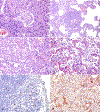Domestic cats are susceptible to infection with low pathogenic avian influenza viruses from shorebirds
- PMID: 22732359
- PMCID: PMC11369772
- DOI: 10.1177/0300985812452578
Domestic cats are susceptible to infection with low pathogenic avian influenza viruses from shorebirds
Abstract
Domestic cats are susceptible to infection with highly pathogenic avian influenza virus H5N1, resulting in pneumonia and in some cases, systemic spread with lesions in multiple organ systems. Recent transmission of the 2009 pandemic H1N1 influenza virus from humans to cats also resulted in severe pneumonia in cats. Data regarding the susceptibility of cats to other influenza viruses is minimal, especially regarding susceptibility to low pathogenic avian influenza viruses from wild birds, the reservoir host. In this study, the authors infected 5-month-old cats using 2 different North American shorebird avian influenza viruses (H1N9 and H6N4 subtypes), 3 cats per virus, with the goal of expanding the understanding of avian influenza virus infections in this species. These viruses replicated in inoculated cats based on virus isolation from the pharynx in 2 cats, virus isolation from the lung of 1 cat, and antigen presence in the lung via immunohistochemistry in 2 cats. There was also seroconversion and lesions of patchy bronchointerstitial pneumonia in all of the cats. Infection in the cats did not result in clinical disease and led to variable pharyngeal viral shedding with only 1 of the viruses; virus was localized in the alveolar epithelium via immunohistochemistry. These findings demonstrate the capacity of wild bird influenza viruses to infect cats, and further investigation is warranted into the pathogenesis of these viruses in cats from both a veterinary medical and public health perspective.
Conflict of interest statement
Declaration of Conflicting Interests
The authors declared that they had no conflicts of interest with respect to their authorship or the publication of this article.
Figures

Similar articles
-
Distribution of lesions and antigen of highly pathogenic avian influenza virus A/Swan/Germany/R65/06 (H5N1) in domestic cats after presumptive infection by wild birds.Vet Pathol. 2007 May;44(3):261-8. doi: 10.1354/vp.44-3-261. Vet Pathol. 2007. PMID: 17491066
-
Avian H5N1 influenza in cats.Science. 2004 Oct 8;306(5694):241. doi: 10.1126/science.1102287. Epub 2004 Sep 2. Science. 2004. PMID: 15345779
-
Low pathogenic avian influenza isolates from wild birds replicate and transmit via contact in ferrets without prior adaptation.PLoS One. 2012;7(6):e38067. doi: 10.1371/journal.pone.0038067. Epub 2012 Jun 1. PLoS One. 2012. PMID: 22675507 Free PMC article.
-
Avian influenza A H5N1 infections in cats.J Feline Med Surg. 2008 Aug;10(4):359-65. doi: 10.1016/j.jfms.2008.03.005. Epub 2008 Jul 10. J Feline Med Surg. 2008. PMID: 18619884 Free PMC article. Review.
-
Influenza virus infections in dogs and cats.Vet Immunol Immunopathol. 2010 Mar 15;134(1-2):54-60. doi: 10.1016/j.vetimm.2009.10.009. Epub 2009 Oct 14. Vet Immunol Immunopathol. 2010. PMID: 19896216 Review.
Cited by
-
Molecular Detection of Parvovirus in Captive Siberian Tigers and Lions in Northeastern China From 2019 to 2021.Front Microbiol. 2022 May 12;13:898184. doi: 10.3389/fmicb.2022.898184. eCollection 2022. Front Microbiol. 2022. PMID: 35633695 Free PMC article.
-
Post-pandemic seroprevalence of human influenza viruses in domestic cats.J Vet Sci. 2016 Dec 30;17(4):515-521. doi: 10.4142/jvs.2016.17.4.515. J Vet Sci. 2016. PMID: 27030198 Free PMC article.
-
First Detection of Avian Lineage H7N2 in Felis catus.Genome Announc. 2017 Jun 8;5(23):e00457-17. doi: 10.1128/genomeA.00457-17. Genome Announc. 2017. PMID: 28596397 Free PMC article.
-
Genetic Adaptation of Influenza A Viruses in Domestic Animals and Their Potential Role in Interspecies Transmission: A Literature Review.Ecohealth. 2016 Mar;13(1):171-98. doi: 10.1007/s10393-014-1004-1. Epub 2015 Jan 29. Ecohealth. 2016. PMID: 25630935 Review.
-
Avian Influenza Virus Infections in Felines: A Systematic Review of Two Decades of Literature.Open Forum Infect Dis. 2025 May 7;12(5):ofaf261. doi: 10.1093/ofid/ofaf261. eCollection 2025 May. Open Forum Infect Dis. 2025. PMID: 40390703 Free PMC article. Review.
References
-
- Cottey R, Rowe CA, Bender BS. Influenza virus. In: Current Protocols in Immunology. New York: John Wiley & Sons; 2001, 19.11.1–19.11.32. - PubMed
-
- Driskell EA, Jones CA, Stallknecht DE, et al. Avian influenza virus isolates from wild birds replicate and cause disease in a mouse model of infection. Virology. 2010;399:280–289. - PubMed
Publication types
MeSH terms
Grants and funding
LinkOut - more resources
Full Text Sources
Medical
Miscellaneous

